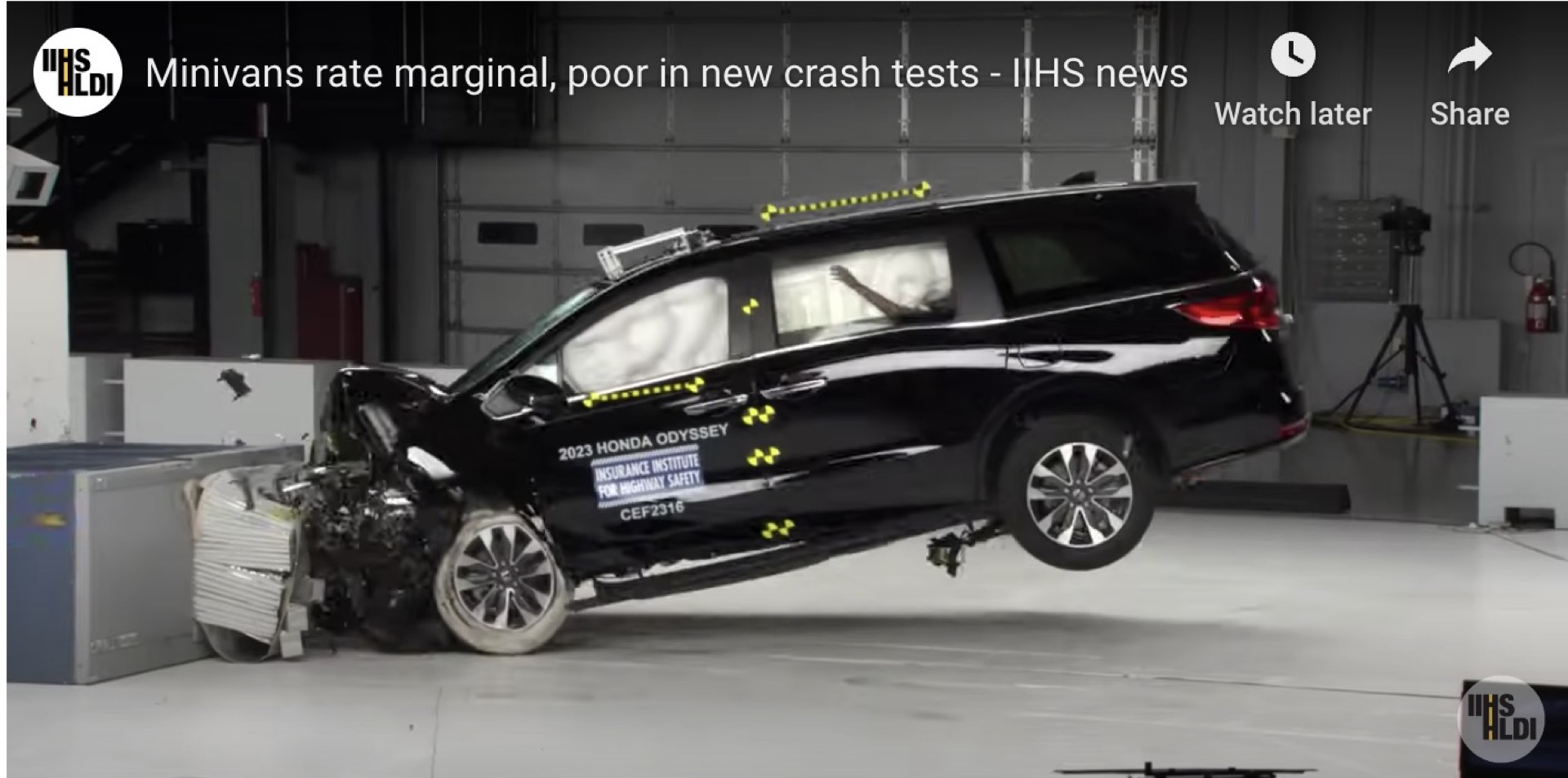Minivans fail to adequately protect rear-seat passengers, based on a new crash-test study performed by the Insurance Institute for Highway Safety released Tuesday.
The test simulates a head-on collision of two vehicles of similar weight traveling just below 40 mph, and measures the impact on a dummy seated behind the driver that replicates a small woman or 12-year-old child in the rear seat. None of the four minivans tested earned “Acceptable” or “Good” ratings, with the Chrysler Pacifica, Kia Carnival, Toyota Sienna earning “Marginal” ratings. The Honda Odyssey rated at “Poor.”
“Back seat safety is important for all vehicles, but it’s especially vital for those, like minivans, that customers are choosing specifically to transport their families,” IIHS President David Harkey said in a statement.
As part of the organization’s updated front overlap test, the rear dummy gets tested for excessive risk of injury to the head, neck, chest, abdomen, or thigh. Chest injuries are a particular focus since they are the most common serious injury in the rear seat for adults. It also tests to see if the body “submarines” beneath the lap belt, or slides down and forward in the seat so the lap belt hits the chest or neck area in the event of crash.
Launched this year to put a spotlight on rear-seat safety, the new test has flummoxed other automakers and vehicle segments, as well. Of the 13 midsize and three-row crossovers tested, only the Ford Explorer, Ford Mustang Mach-E, Subaru Ascent, and Tesla Model Y earned “Good” ratings. Of the 15 small and compact crossovers tested, only the Ford Escape and Volvo XC40 earned “Good” ratings. Nine of the models tested rated at “Poor.”
Results were similar for most sedans that were tested, with the exception of the 2023 Honda Accord. It was redesigned this year, and the IIHS typically informs automakers of changes to its testing a year or two in advance to give them a chance to respond. The Honda Odyssey was last redesigned in 2018, and is expected to be redesigned for 2025. The Accord and Pilot three-row SUV were redesigned this year and have earned top safety ratings from the IIHS.
IIHS minivan crash-test results
The IIHS found that the Odyssey’s dummy had elevated forces to the head and neck, and the head came too close to the front seatback. But all four minivans were lacking in rear-seat protection, while excelling at front-seat protection.
“The restraint systems in all four vehicles leave the second-row occupant vulnerable to chest injuries, either because of excessive belt forces or poor belt positioning,” Jessica Jermakian, IIHS vice president of vehicle research, said in a statement. “That’s concerning because those injuries can be life-threatening.”
The nonprofit agency funded by the insurance industry noted that only the Toyota Sienna has seat belt reminders for rear passengers.
The updated test measures the safety of rear occupants at a time when crash safety has focused on front occupants. Not long ago, the rear seats were considered the safest place in a car. Much has changed on roadways since the original moderate overlap front crash test launched in 1995. In recent years, car cabins have incorporated more rigid crumple zones so there is less deformation from a front crash in the passenger cabin. More front airbags and advanced seat belts also have benefited front passengers.
Since 2007, the risk of a fatal injury in a crash is 46% higher for belted rear passengers than belted front passengers, according to the IIHS.
The IIHS updates its tests as more automakers attain “Good” ratings, continually raising the safety bar for automakers to earn its coveted Top Safety Pick and Top Safety Pick+ honors. This year, the emphasis has broadened to include pedestrian safety as a direct result of record pedestrian fatalities, and in 2021 it toughened the criteria for its side-impact test.
https://www.thecarconnection.com/news/1140866_minivans-don-t-adequately-protect-rear-seat-passengers-iihs Minivans don’t adequately protect rear-seat passengers: IIHS








